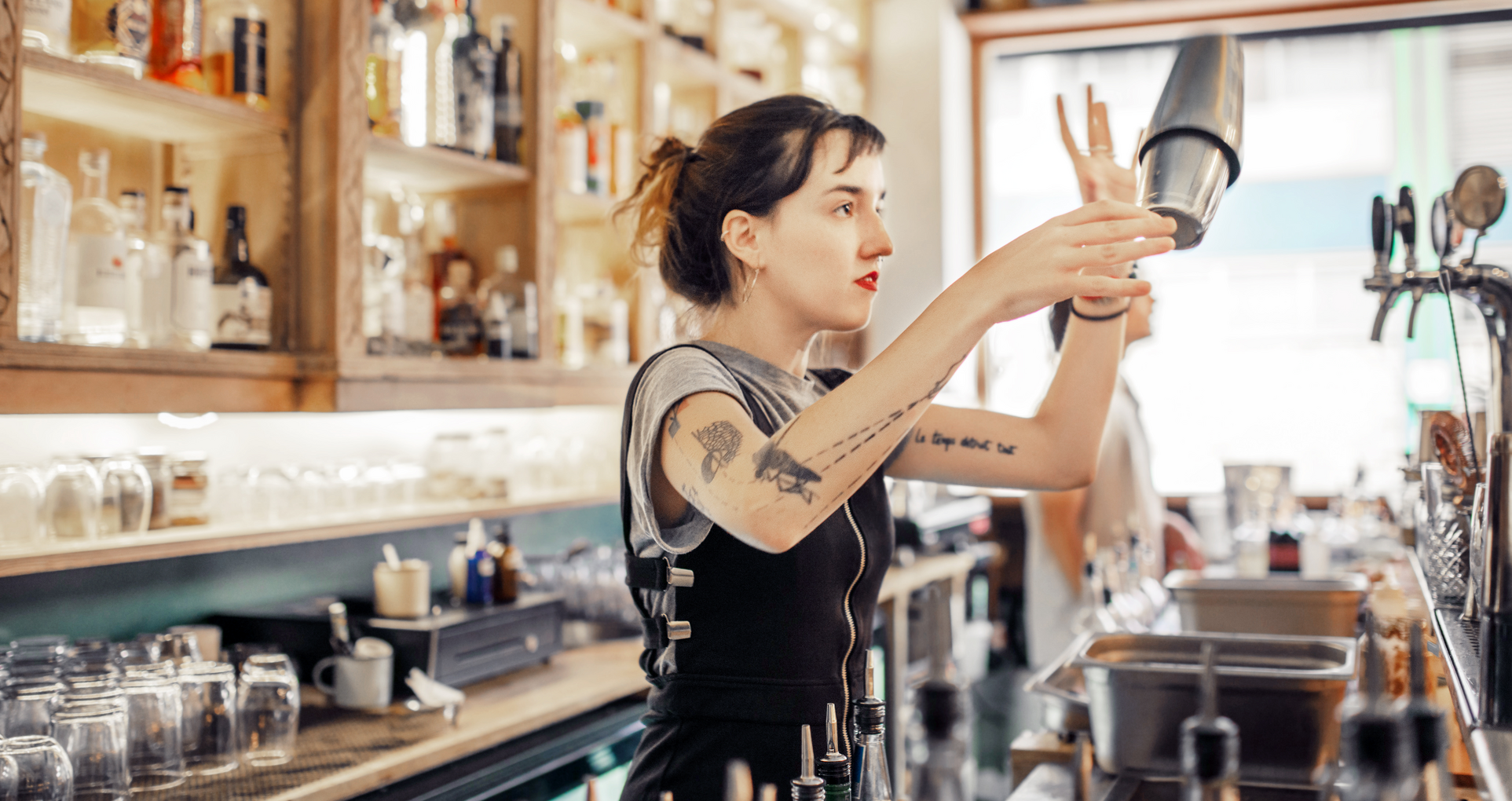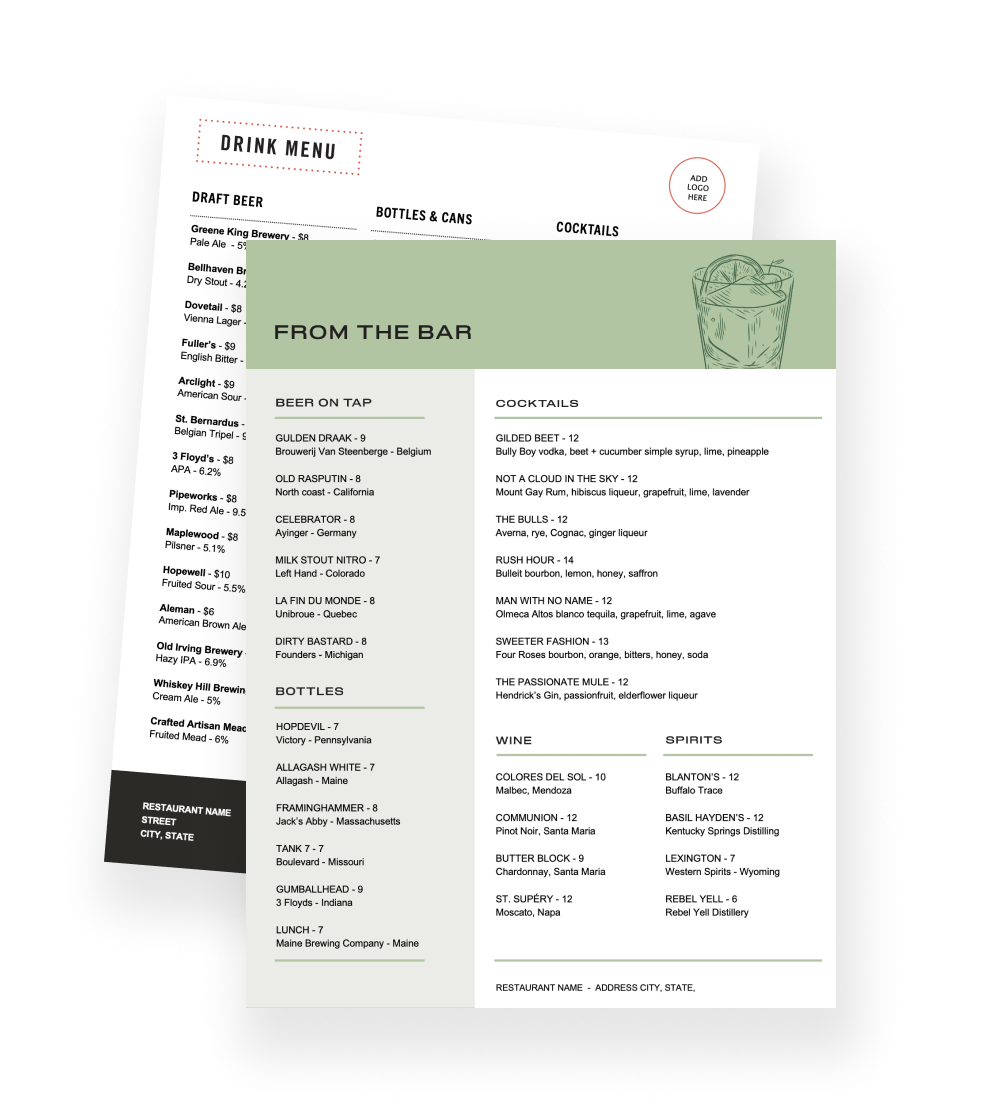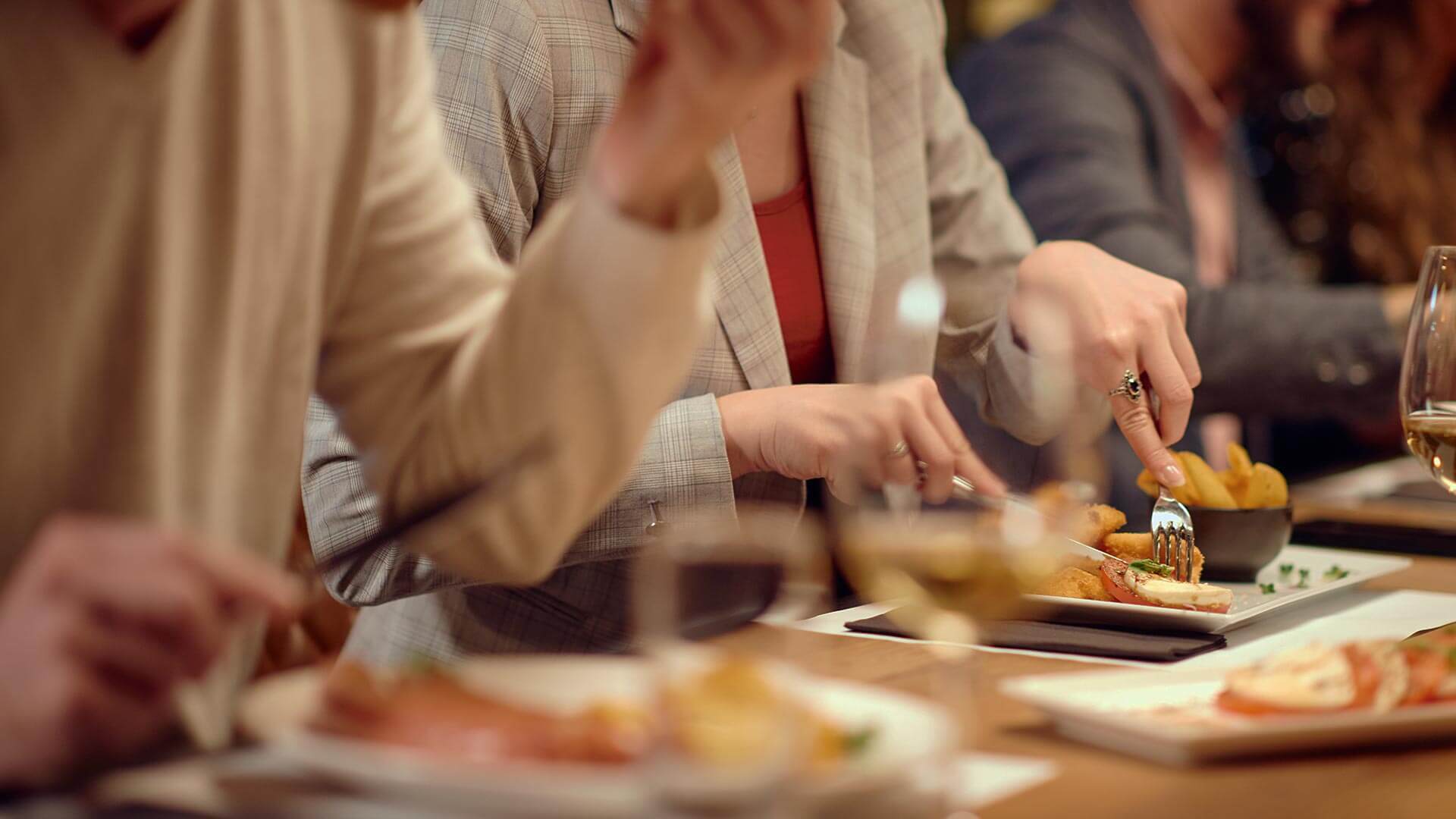
How to Make a Bar Menu With Examples (Free Template)
Everything you need to know to develop, engineer, and design your perfect bar menu.
Maddie RocklinAuthor

Bar Menu Templates
Use these bar menu templates as a starting point for your menu design or to give your menu a refresh.
Get Free Download | Built for Restaurants
| Built for RestaurantsHow do you design a bar menu?
Designing menus and graphics in-house is a great way to save, but hiring a designer streamlines the process. If you decide to do do-it-yourself, use design software like Adobe Creative Suite, Canva, or Powerpoint to create designs with a professional finish.
Whether doing it yourself or working with a designer, keep these design best practices in mind. Our bar menu templates can help you to get started.
How to Create a Bar Menu
The wall behind the bar is stocked with bottles, different colors illuminated in the mood lighting from well to top shelf. Garnishes are laid out on the counter – lime wedges, cherries, orange slices, and sprigs of mint organized into neat boxes. The ambiance is perfect – a little dramatic, a little exciting, beckoning your customers inside the front door. You’ve nailed the aesthetic, and even the toughest critics are anxiously awaiting the grand opening of your new bar.
But before you can live out this fantasy, there’s one very important component you need to build: your menu. This process is about much more than just listing out the drinks and bar food your establishment provides. From the composition of your drinks to the composition of your menu, the colors of your drinks to the brand colors you choose to decorate your menu, from your printed handouts to digital versions, your menu is a tool. It provides you an opportunity to drive customer engagement, maximize revenue, and establish yourself as a brand that stands out in a crowded market. Below, we’ll go through all the steps you need to know to take advantage of this opportunity to strategically design a bar menu that works best for you and your business.
Bar Menu Design Best Practices
Your bar menu should reflect the uniqueness and individuality that makes your business your own, so there are no hard and fast rules for menu creation across the board. There are, however, some menu design best practices that can be helpful for any establishment looking to deliver a top-tier menu.
The Ultimate Guide to Restaurant Branding
Use this guide to get tips on how to create a restaurant brand that stands out, attracts customers, and drives repeat visits.

How to Make a Bar Menu
These next ten steps go through everything you need to consider as you put your menu together – from inventorying your menu items to proofreading and printing your final product. Let’s get into it!
1. Write Out All Menu Items
The first step is taking note of every single item that will go on your menu, so pull up your organizing tool of choice – Excel, Google Sheets, notepad, etc. – and get ready to inventory.
From your wines – reds, whites, rosés, skin contact, champagnes, and proseccos – to your beers – IPAs, lagers, stouts, and ales, on draft and by the bottle or can – to your liquor – vodkas, tequilas, gins, bourbons, whiskeys, and rums – to any specialty cocktails or bar food, if you’re selling it to your customers, it goes on the list.
Beyond your standard list of beverages and snacks, are there any specials or deals you can include? Certain drinks or food items that are only available at happy hour or late night? If you’re planning to serve espresso martinis, will you also take advantage of your espresso machine to offer coffee and tea? If so, will you carry milk or substitutions? Think outside the box – anything that could potentially add revenue should be included here.
2. Categorize Menu Items
Now that you have your list of items, think about how you want to organize them. What will make the most sense to your customer? What categories will be most intuitive and accessible?
This step might seem fairly simple (alcohol is pretty much already organized into distinct categories) but don’t underestimate its importance. Even if you have your broad categories down (wine, beer, spirits, cocktails), how will you organize the offerings you include within each category?
How will you make high-price items stand out to drive revenue? Will the most expensive drinks go first?
How will you distinguish between wine by the bottle or by the glass? Will they be in the same section with different prices to differentiate them, or separate sections altogether?
If you’re including food or coffee, where will they fall? Will coffee go with digestifs? Will your food be organized into different sections, or listed all together in one?
The answers to all of these questions will be instrumental in helping you optimize your menu in a way that maximizes profits, while also making it easier for you and your team to track the items you’re selling. Tools like this menu engineering worksheet can also be great resources for exploring different bar menu templates and finding what works best for your business.
3. Set Menu Prices
Now that you have your items and their categories, the next step is determining how much you’ll charge for them.
Here are a few components to consider as you calculate your menu prices:
Your target market. What prices will be both accessible to the customers you’re trying to reach, while still generating a sustainable profit?
Your expenses. What costs do you have to ensure your revenue will cover? These can add up so make sure you’re accounting for everything, including staff compensation, benefits, cleaning, maintenance, repairs, health and safety measures, overhead, inventory, and anything else you’re on the hook for.
Your competitors. How much are other bars in your area charging, and where do you fall in that range? Can you charge more for offering creative cocktails or a unique selection of craft beer? Can you charge less and be a more appealing option to customers who might otherwise go somewhere else?
Your talent. Does your bartender have 30 years of experience creating one-of-a-kind cocktails at some of the best bars in New York City? Is your chef known for creating unique and delicious late-night treats? The experience of your staff adds value to the drinks they’re creating, and prices should reflect that.
Your relationship with your customers. People tend to value transparency, so being honest with your customers about why something is priced the way it is can actually help to build trust. Maybe your ingredients are more expensive because they’re locally sourced through a rooftop farm, or your coffee is fair trade certified – let your guests know.
Data and Psychology. Tools like this menu engineering course can provide valuable insights about the latest science and research that can help inform your bar menu design.
Learn more about creating a menu pricing strategy here.
4. Create Menu Descriptions
You can know what you’re selling, but if you’re not communicating it to your customers it’s a moot point. This is your chance to fill in any details your guests will need to know when it comes to choosing their orders.
When it comes to describing your menu items, you have total creative license – so have fun! Think about what tone you want to strike, and how it will match the rest of your bar design. Will you be funny or serious, witty or minimalist? Will you list every single ingredient in every drink and dish, or provide a more general overview? How will you flag potential allergies or dietary restrictions?
Put yourself in your customer’s shoes and imagine what you’d want to know before you ordered – then include whatever comes to mind, in whatever style feels most aligned with your overall vibe. If you’re struggling to come up with descriptions for your menu items, this is also a good step to pull in a copywriter for additional support, if needed!
Menu Engineering Worksheet
Use this menu engineering worksheet, complete with intricate menu engineering formulas, to determine areas of strength and weakness in your restaurant's menu.

5. Decide on a Menu Color Scheme
It’s time to get more into the visual design of your menu. Let’s start with your color scheme!
What colors represent your bar? Do you already have a brand kit that you can incorporate into your menu design, or are you starting from scratch as you come up with your bar’s visual identity? If the latter, here are some resources you can explore to help you think through which colors would work best for your menu design:
Even if you have a brand kit already, another important component to consider is printing costs. Because color printing tends to be a bit pricier than black and white, make sure to factor in how many menu copies you’ll be printing, what the potential costs would be for different color schemes, and whether those colors schemes feel worth the cost (or if a simple, minimalist-chic black and white vibe would actually work just fine).
6. Design Your Bar Menu
It’s worth beginning this section with a reminder that delegating is a skill, and it is totally okay to outsource your menu design to a professional for any and all graphic design needs, if that’s an option you’re interested in exploring.
If you’d rather keep your momentum going and create the design yourself, there are tools and resources available to help you with that process, like Adobe Suite, Canva, Pinterest, or other menu templates.
As you work out the design of your menu, think about how the sections are flowing – how intuitive is your menu to read? Have you labeled your sections in a way that’s clear and easy to navigate? Are your pages overwhelming, crowded with too much information, or spread out in a way that feels accessible to your reader? Are your prices easy to find, and do your higher-end items stick out? You can also explore our menu engineering course’s section on menu design, or review these menu design best practices, for some additional menu design strategies and insights.
7. Bar Menu Photos
Allowing your customers to put a “face” to the name of their drinks can be a significant value-add for your menu, teasing the experience and letting your guests get excited about the delicious and innovative cocktails they’re about to consume.
While professional, high-quality shots are often the best option, feel free to get creative with it – concepts like hand-drawn illustrations or collage-type vibes can also have just as powerful an impact in terms of engaging your audience, and are sometimes even more fitting for the aesthetic you’re going for.
You can also combine different approaches, leveraging vehicles like your website and social media as resources for customers to browse photos that showcase your offerings but don’t make it onto the menu itself. Including a QR code or Instagram handle on your menu can also be a strategic way to encourage guests to share their own photos from your bar, generating online buzz while also providing you with a stock of images to repost.
8. Choose Menu Fonts, Spacing, and Composition
This step is focused on finalizing the rest of your menu’s visual design components – your fonts, spacing, and composition. How many fonts will you deploy? Will you stick with one throughout, or incorporate multiple styles and sizes? How will you make sure they complement each other and aren’t too busy on the page?
What about your spacing? Will each section be evenly spaced out, or will certain sections be slightly different? How will you space the items you list within each section? What about your photos or illustrations, where will they live on the page?
Your menu is a dynamic document, changing and evolving as your bar changes and evolves, so make sure whatever you choose leaves room for flexibility. If you need help brainstorming this step, you can also check out these bar menu templates.
Menu Engineering Course
Take this course to make the most of your menu. Learn about menu psychology and design, managing your menu online, and adapting your menu to increase sales.

9. Select the Final Menu Layout
Three words: Feedback, feedback, feedback!
And then more feedback.
Seriously, this is your chance to get thoughts from all of your key stakeholders, staff, family, friends, and any other trusted sources, and incorporate them into your menu design before it’s locked in and off to the printer.
Ultimately, you know your bar’s brand better than anyone, so take the advice that resonates but also don’t be afraid to choose whatever layout that feels right for you. And give yourself a pat on the back – if you’ve made it this far, the hardest parts are over. You’re almost done!
10. Proofread and Print Your Menu
This brings us to the final (and arguably most important) step – proofread and print your menu.
Give your final design a very, very close read. Customers *will* notice any typos or grammar mistakes, so take your time going through your menu and making sure you’re avoiding any of those preventable errors. This is another place you can loop in your trusted stakeholders – fresh sets of eyes are always welcome for additional review and copy edits.
Once you’re confident your menu is in the best shape it could possibly be in – it’s off to the printers! There are a variety of printing service options across a range of price points, such as Staples, Vistaprint, PsPrint, and PrintPlace, but feel free to do your own research to find the option that works best for you.
You did it – CHEERS!
Bar Menu Templates
Use these bar menu templates as a starting point for your menu design or to give your menu a refresh.

Examples of Bar Menus
Thunderbolt – Los Angeles California
Echo Park’s Thunderbolt absolutely nails its cocktail menu. The color scheme is fun but not overwhelming, with calm, earthy tones that feel both balanced and complementary. Their drink descriptions include the ingredients, but also a witty quip for their readers’ amusement. They combine a more simple, straightforward font for menu items and descriptions with a more whimsical title cursive that adds an air of cheerfulness and levity. They note which cocktails donate $2 to organizations, like the CA Farmworker Foundation and the Echo Park Trash Club. And while the illustrations of each drink don’t give much insight into what it will look like upon arrival, they add a necessary playfulness to what would otherwise be a relatively simple menu. 10/10.
Melody – Los Angeles, California
This is one of my personal favorites. The collage-like background, combined with the super funky fonts and illustrations make this menu so much fun to look at and engage with. While there are a lot of colors at play here, they all work well together, keeping the page from feeling too busy. The font itself is intense, but the consistency of the same style throughout again balances the page and prevents the viewer from feeling overwhelmed by the visual. The handwritten vibe makes it feel like a personal gift – as if a friend cut these pieces out of a magazine and made a piece of art just for me. In terms of the content, the schedule and main info page listed here includes everything guests need to know to plan their visit. The menu and bottle list are easy to navigate to, and maintain the same aesthetic, creating a pleasing sense of brand consistency throughout and establishing a familiarity between the guest and the bar. It’s artistic and tasteful, exciting and visually charming, informative and engaging. A+.
Hecate – Boston, Massachusetts
If you love a theme, this menu (and bar) is for you. Complete with page-turning sound effects, elaborate illustrations, and engaging storytelling there’s no doubt Hecate’s menu will put you under its spell. In fact, every page in this spellbook is a different drink, complete with descriptions listed in fonts reminiscent of fairy tales or something you’d find on the wall of the Hog’s Head Inn in Hogsmeade. One pass through this menu and you’ll have no choice but to let the magic happen.
Bar Pallino – Boston, Massachusetts
On the other side of the spectrum, Bar Pallino’s menu is simple, clear, concise, and effective. With a black-and-white color scheme, this menu takes a minimalist approach, yet still manages to add some unique flair with playful fonts, sizing, and spacing. The drink categories are clearly labeled and easy to navigate through, and a note to the customer at the top clearly communicates what to expect upon arrival. Extra points for the beautifully shot, professional photos of the bar’s interior, including several rows of wine and spirits, that brighten up the menu page and preview the experience for the viewer.
Broken Shaker – Miami, Florida
Miami’s Broken Shaker is a perfect example of how less can be more. With only two colors in their palette, yellow and black, they manage to create an unexpectedly diverse visual experience, leveraging font outlines, bold fonts, and cheeky illustrations to draw the viewer in. Their sections are clearly labeled and easy to find, their descriptions include all relevant ingredients, and there’s not so much information as to lose track of what your options were to begin with. The shaker might be broken but this menu certainly is not in need of fixing.
Sweet Liberty – Miami, Florida
Everything about Sweet Liberty’s menu reflects its tropical Miami surroundings, from the green and yellow color scheme, to the palm tree illustrations, to cocktails with names like “Coconut sazerac,” “The Florida Cocktail,” and “Golden Sunset.” Reading this menu feels like laying in a beach chair, piña colada in hand, watching the sunset over the ocean. With well-spaced menu items, playful drink names and section titles, and easy-to-navigate sections, this menu is a sweet success.
Nobody’s Darling – Chicago, Illinois
The menu at Nobody’s Darling is as sexy and straightforward as the bar’s name. With a simple red, white, and black color scheme, and basic block fonts combined with swooping cursive titles for each section, this menu gets right to the point, but looks good doing it. Suggestive cocktail names, like “Carry Me Home Darling,” “Love and Trouble,” and “Desire,” evoke a romantic yearning with a wild twist – consistently maintaining the bar’s brand from its name to its logo to its menu items. The menu also denotes which items on the menu come from Black- and women-owned businesses and offers a QR code to access a fully curated list of high-end spirits, important details to communicate and inform guests’ orders. This establishment may be nobody’s darling, but with its seductive charm and hella rizz, it just may become somebody’s new go-to spot.
MACE – New York, New York
Field guide or menu? With its beautiful botanical illustrations, the menu at MACE in New York City could honestly be either one. The written portions of the menu items are overwhelmingly minimalistic – black text on a white background, item names, and descriptions listed in simple, elegant font styles – but the stunning drawings of plants and flowers next to each item are more than enough to engage the viewer and elevate the page. And with unique and innovative concoctions – including “olive oil-washed shochu sorghum spirit, seaweed oleo saccharum, lemon juice, chervil, olive oil” and “goat cheese-washed rye whiskey + cognac, cashew syrup, thyme bitters” – one simply can’t help but be intrigued enough to swing by. MACE aced this one.
Sunny’s – Brooklyn, New York
Originally opened as a saloon in the 1890s, Sunny’s has been a Red Hook, Brooklyn institution for well over 100 years. For those familiar, this legendary and beloved establishment needs no introduction – so it only makes sense that its menu takes the same low-key, no-frills approach. Clear, straightforward, and more focused on being a vehicle in service of the in-person experience than an experience in and of itself, Sunny’s menu is exactly the vibe one familiar with this iconic bar might expect. Stroll in, chat with other guests, listen to the live band playing on any given night, order a glass of Field Recording Orange wine off this menu, slow down, and take it all in. Ahhh.
Tweedy’s – Austin, Texas
With a two-tone brown color scheme framed by a bright orange background, Tweedy’s menu evokes the feeling of watching the sunset over a dusty mountain range, a peaceful yearning and a natural calm beckoning customers to sit down, have a drink, and relax as the day winds down. Basic menu item fonts and pleasantly-spaced sections, combined with playful header fonts and illustrations, clearly convey the bar’s offerings with a subtle jovialness. The bar’s hours, phone number, and location are all easy to locate, ensuring their guests have everything they need to know to plan their visit. Per their website, hats off inside – and hats off to a lovely menu design.
Related Menu Ideas
Is this article helpful?
DISCLAIMER: This information is provided for general informational purposes only, and publication does not constitute an endorsement. Toast does not warrant the accuracy or completeness of any information, text, graphics, links, or other items contained within this content. Toast does not guarantee you will achieve any specific results if you follow any advice herein. It may be advisable for you to consult with a professional such as a lawyer, accountant, or business advisor for advice specific to your situation.
Read More
Subscribe to On the Line
Sign up to get industry intel, advice, tools, and honest takes from real people tackling their restaurants’ greatest challenges.
By submitting, you agree to receive marketing emails from Toast. We’ll handle your info according to our privacy statement. Additional information for California residents available here



